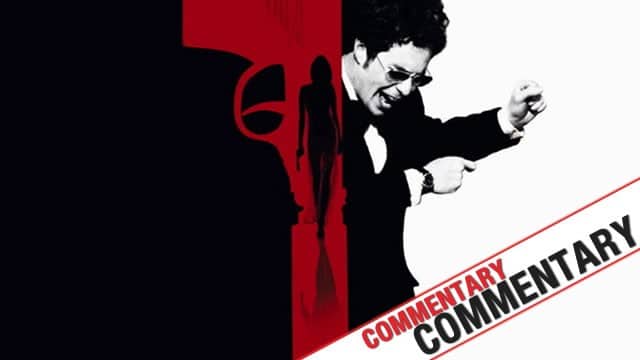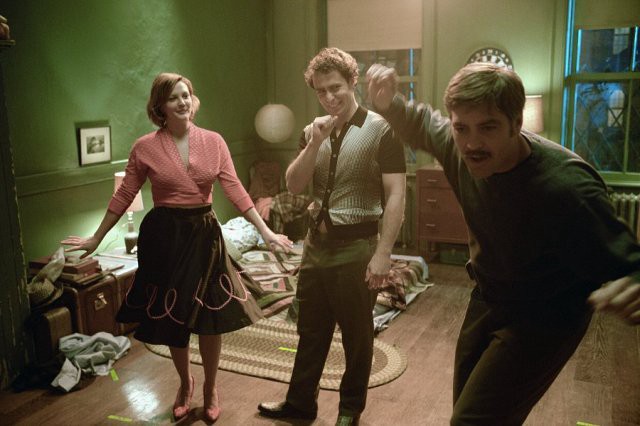26 Things We Learned From the ‘Confessions of a Dangerous Mind’ Commentary

Actors’ behind-the-camera debuts are rarely great. There’s generally a safeness to those movies, where it feels more like an actor testing the waters than having a story they need to tell. A big exception to that trend: George Clooney. Clooney took a major chance on Confessions of a Dangerous Mind. Sure, he had a script written by Charlie Kaufman (Adaptation), but he made bold choices as a filmmaker. From the film’s complex style, the timeline they have to show in two hours, and the tonally tricky humor, Clooney’s first directorial outing was an ambitious introduction.
Since then he’s tried his hand at varying material, constantly pushing himself as a filmmaker. Nothing against his films since 2002, including the overlooked Leatherheads, but Confessions of a Dangerous Mind remains his best picture. This is a film where big choices were made, and every single one of them hit their mark. It’s an emotional dark comedy that not many filmmakers could pull off.
Confessions of a Dangerous Mind (2002)
Commentators: Director/co-star George Clooney and cinematographer Newton Thomas Sigel
1. End of the Road was an inspiration for the film’s opening scenes as was the sound design from 2001: A Space Odyssey. They wanted the sound to accelerate and cutoff.
2. Sam Rockwell had to spend his first day of shooting naked. Everyone was uncomfortable except for Rockwell.
3. The “Strawberry Dick” scene with Chuck Barris as a kid, played by Michael Cera, was what scared most studios away from making the film.
4. There’s only one VFX shot in the movie, because Clooney wanted to rely on in-camera effects.
5. They decided to use subtle makeup and, most importantly, acting to portray Barris’ aging.
6. A Place in the Sun is homaged when Barris and Penny (Drew Barrymore) first meet. Clooney was having a difficult time figuring out how to stage this scene, but after watching A Place in the Sun, he figured out how to create the right electricity between the two characters.
7. When Jim Byrd (George Clooney) and Barris are introduced, Clooney jokes about being able to see modern cars in the background. Sigel and Clooney tried to keep them out of focus. They’re hardly noticeable.
8. They almost killed actor Robert Burke with the camera.
9. Originally there was a whole sequence showing Barris’ first mission where the target was accidentally killed, but it came too early in the film. The gore didn’t sit well with the establishing humor, so they played with it in editing and built up to the death instead, saving it for the film’s dark turn.
10. Barris’ not-so-charming personality also posed a challenge in getting the film made.
11. There was originally a line about an “old lady’s dried up snatch,” but since it offended everybody, they cut it. We missed out.
12. When Byrd gave Barris the travel idea for the dating game it’s shot from a distance, with Clooney and Sigel tipping their hat to cinematographer Gordon Willis’s iconic work on The Parallax View.
13. When Patricia Watson (Julia Roberts) entered the story, they wanted to achieve a film noir aesthetic. Visually they wanted to pose the question: what if this spy business really is all a fantasy? To create that look, for the bar scene, they took most colors out, but left the color red prominent.
14. Marlon Brando had an off-screen cameo. He voiced the man Barris shot after his meeting with Watson.
15. Roberts came up with the idea of Watson licking Barris’ face.
16. They did 86 takes of Barris throwing the “For Sale” sign.
17. When Clooney felt a scene needed some spark, he’d tell Rockwell to dance. Which should be standard practice on all movie sets.
18. When Byrd tells Barris about the mole to “Won’t Get Fooled Again,” Clooney & Co. came up with the idea of using subtitles while on an airplane. They hate it when movies feature characters playing music, in case there’s a bug in a room, while the audience can still hear everything they’re saying.
19. Screenwriter Akiva Goldsman had a cameo at the playboy party scene. He shot his bit a month after winning an Academy Award for A Beautiful Mind. That playboy party was designed as the film’s turning point, where Barris’ world begins to fall apart. “Everything that started off as cute becomes ugly,” says Clooney.
20. Rutger Hauer wasn’t interested in sticking to the script, which didn’t bother Clooney. He wanted to let Hauer run with it.

21. When Penny catches Barris with Watson in their home, it was originally done in split-screen, showing Penny pull up to the house. It worked, but Clooney preferred cutting to Penny’s expression when she saw them together. Wise choice.
22. In the following scene where Barris consoles Penny, which was Barrymore’s final day of shooting, Clooney and Rockwell knew they had to be careful with that moment. If Barris didn’t seem genuine, the audience would’ve completely turned against him.
23. The pool scene, where Byrd draws Barris outside by playing music, was another loving nod to Sydney Pollack’s Three Days of the Condor. Clooney nodded to a lot with his debut.
24. Sigel makes an insightful point about the lack of reliance on sound design to create a mood. Clooney agrees that films generally rely more on music to build an emotion.
25. The shots of the dead audience were initially meant for when Barris’ show was killed, but later they decided to use those images during the “If I Had A Hammer” sequence.
26. In Kaufman’s original draft Barris shot Watson in her apartment right away, but Clooney wanted to play the death out and express how smart these characters are. Clooney jokes playing smart is asking for a lot from actors.
Best in Commentary:
- “It’s very frustrating to act and direct. You can’t do more takes on yourself, because then everybody gets mad.” – Clooney
- “No matter what you can do in the digital world, you’re still limited.” – Sigel
- “Silhouette has been done for 100 years, but when it really has an organic purpose to what’s dramatically going on in a scene, it’s as if it’s never been done before.” – Sigel
- “When the film came out a lot of people were asking, ‘What kind of statement were you trying to make having the coffin go in the back of the church while the bride and groom come out of the front?’ I was just making a joke about marriage!” – Clooney
- “I sandpapered the nipples off the batsuit and sold them to Planet Hollywood for $100,000.” – Clooney
Final Thoughts:
There’s plenty of “I love this shot” and “that day was fun” comments, but you can’t blame Cooney for being excited with how his first directorial effort turned out. His passion for filmmaking and films in general is obvious. Some of the best parts of the commentary are hearing Clooney give props to other movies that served as reference points. And there are a lot.
While he loves a lot of scenes in his film, he’s also not afraid to poke fun at himself and some technical flubs. The only genuine ill that can be said of this commentary is, unless I’m mistaken, Clooney doesn’t mention Kaufman once. Maybe Clooney did a massive overhaul of his script and wasn’t credited? Even if that’s the case, it’s strange he doesn’t even discuss Kaufman’s work. Still, it’s a nitpick in an otherwise informative commentary. Clooney and Sigel’s rapport is quite evident, making this an engaging and very funny conversation between two rightfully proud filmmakers.
Check out more commentary commentary in the Commentary Commentary archives
Related Topics: Commentary Commentary, George Clooney

